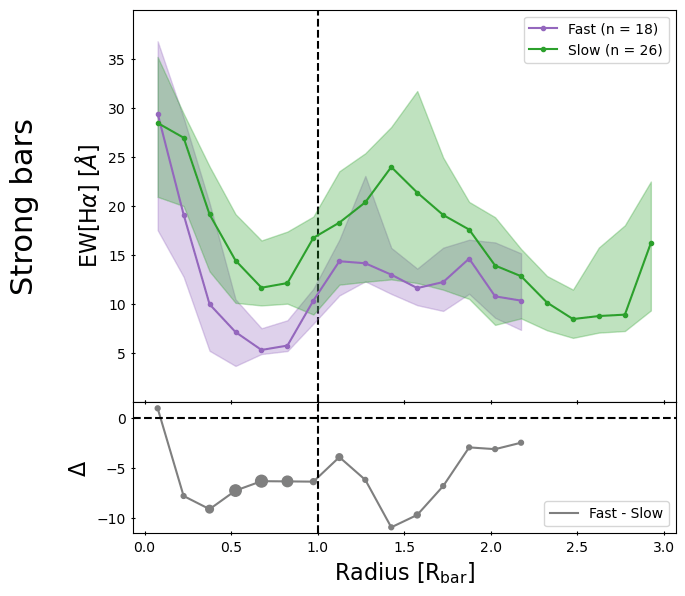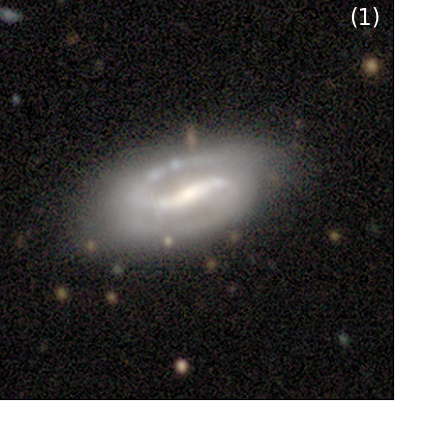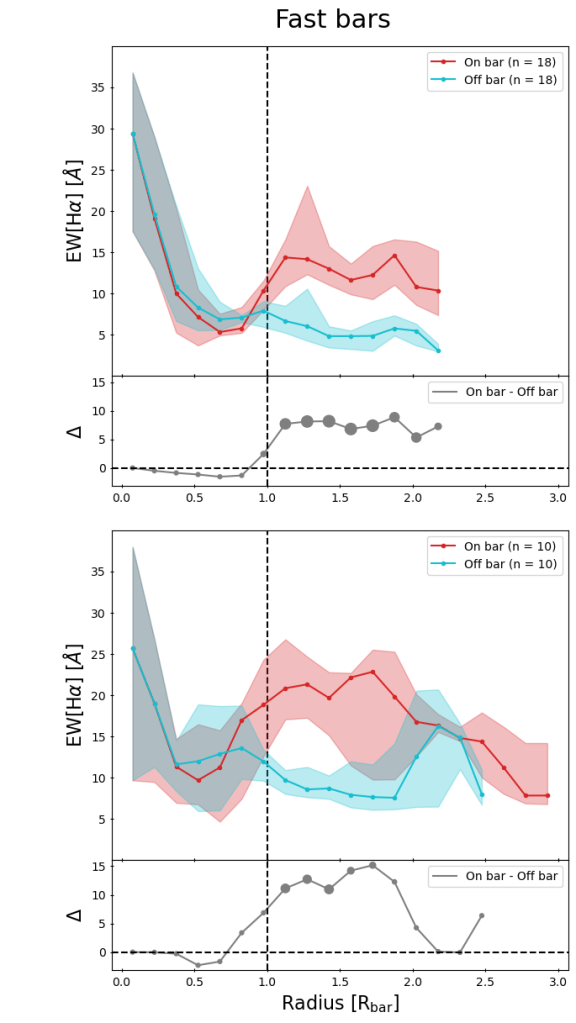Slow strong bars affect their hosts the most
Hi everyone, my name is Tobias. I finished my PhD at the University of Oxford almost a year ago now, and I am currently a postdoc at the University of Toronto. I work a lot with Galaxy Zoo classifications, specifically to study bars in galaxies. We’ve just submitted a new paper (which can be found here), but I thought it would be fun to go over some of the main results in this blogpost. I heavily relied on classifications from Galaxy Zoo in order to identify the bars, so this work would not have been possible without your help!
Introduction
There are different ways to classify a bar in a galaxy. One you are all doubtlessly very familiar with, is a classification based on morphology: bars can be classified as either weak or strong. This is what Galaxy Zoo has been asking volunteers to do since GZ DECaLS.
However, another useful approach to classify bars is based on how they move (i.e. the kinematics). Bars will rotate around the centre of their host galaxy with a specific speed, often called the bar pattern speed (). However, and this is crucial, this rotation rate is disconnected from the rotation rate of the disc of the galaxy. This means that we can classify bars depending on whether they rotate ‘slow’ or ‘fast’ relative to the stars in the disc. Slow bars typically rotate much slower than stars in the disc, whereas fast bars rotate with a velocity similar to the disc (well, technically, the bar-end of a fast bar will rotate with a velocity similar to stars in the disc at the same radius, but that’s a detail). These definitions can feel a bit convoluted at first, but I made an interactive tool to help you get a grasp on what this actually means. If you’re interested, this tool can be found here.
In a previous paper, we tried to measure the kinematics of bars in a bunch of galaxies (this paper can be found here). Bar strength has been reasonably well studied over the last few years, but the kinematics of bars hasn’t been studied observationally to the same degree. Even more, the interplay between bar strength and kinematics (i.e. does a strong slow bar behave the same way as a strong fast bar?) has not really been looked at yet in much detail. This is exactly the topic of our new paper. I have been working on this problem for a while now, and I have recently finished! I’ll go over some of the main findings below, but if you want to learn more, please feel free to check out the actual paper itself: https://arxiv.org/abs/2405.05960
Intermezzo: different regions of a barred galaxy
Before we continue, I want to spend a little time to clarify different regions of a bar. The names are relatively intuitive. The picture below shows a famous barred galaxy called NGC 1300. All credits of the original picture go to NASA, ESA and the Hubble Heritage Team. Overlaid on this image are the different regions of the bar that I will talk about. The bar itself is bounded by the dashed box. The centre of the bar typically coincides with the centre of the galaxy. The bar then has two arms that stretch out either side. The bar-end region is where, as the name implies, the bar ends. The bar-end region where the bar sometimes transitions into spiral arms (as is the case here) or a large ring structure, but this is not always necessarily the case.

How do we study bar kinematics?
We want to study how bar strength and bar kinematics affect their host. Specifically, we will look at how bar strength and kinematics affect the distribution of star formation. I won’t go into too much detail on this now, but the amount of star formation is related to a quantity called the equivalent width of H, also written down as EW[H
]. So whenever you see EW[H
] in the plots and text below, you can simply replace it with “star formation”.
In order to measure how the star formation changes in different locations within the bar, we will create so-called radial plots, which is explained using the Figure below. Panel (1) shows the image of a galaxy. Panel (2) shows the amount of EW[H] (read: star formation) that happens in every pixel. You can already see that there is more star formation along the bar and in the centre of the galaxy. There is also a significant amount of star formation happening in the spiral arm in the top of the plot, but we’ll ignore that for now. Also note the black rectangle drawn over this plot. This is drawn over the bar region, and we will look at the pixels within that box in more detail in Panel (3). Here, we plot the EW[H
] against radius from the centre. Every blue dot here is a pixel within the rectangle from the previous panel. To make comparison between different barred galaxies easier later, we normalise this distance to the length of the bar. This means that, in these units, at R = 1, we are at the end of the bar. At R = 0.5, we are in the middle of the bar. Note that, while there is some scatter, there is a pattern here. There is a lot of star formation in the centre of the galaxy and just beyond the ends of the bar. The black line shows the median value at different radius intervals. This line is shown again in Panel (4) in black. All the grey lines in the background are other profiles of other strongly barred galaxies. We can take an average of all these lines (effectively taking an average of averages) to create an overall profile of EW[H
] of strongly barred galaxies. This is the so-called radial profile.

Effect of bar strength
We can then compare different radial profiles of different groups of galaxies. For example, below, we compare the radial profiles of unbarred (grey), weakly (blue) and strongly barred galaxies (orange). There is a lot going on in these plots, but I’ll walk you through the most important parts. Firstly, the full line is the median radial profile of a group of galaxies (e.g. all strongly barred galaxies), constructed as discussed above. The contours around it show the 33th and 66th percentiles, which can be interpreted as the uncertainty around the median of the radial profile. The bottom part of the figure shows the difference between two radial profiles. Additionally, the size of the dot shows how significant the difference is. A large dot implies that the difference is very significant, while a small dot implies that it is not significantly different.

There are multiple things that we notice. Firstly, the shape of the strongly barred radial profile, when you only look at R < 1.5, is shaped like a “V”: there is a peak in the centre of the galaxy, a minimum in the arms of the bar (at R = 0.5), and a second peak just beyond the bar-end region. This distinct shape is only seen for strongly barred galaxies. The shape of weakly barred and unbarred galaxies are similar to each other: it simply increases slowly with radius. These observations are consistent with the picture that strongly barred galaxies collect gas from the galaxy, and funnel them through the arms of the bar to the centre of the galaxy. This gas is then used in the centre (and to a smaller extent, just beyond the bar-end) to form stars. We can only conclude this for strong bars, not for weak bars.
Effect of bar kinematics
Now that we’re familiar with radial profiles and how to use them, we’ll move to the main point of the paper: what happens when we look into bar kinematics as well? This is done in the Figure below, where we look at the radial profiles of EW[H] for strongly barred galaxies in the left panel and weakly barred galaxies in the right panel. In each panel, we also divide the sample into slow (green) and fast bars (purple). In the left panel, you can see that the radial profile of slow strong bars has higher values of EW[H
] across the board than fast strong bars. However, we also see that the uncertainty is quite large and that the observed differences are not significant. One thing to note is that the sample sizes are relatively small. This is because measuring bar kinematics is not straight forward. This is one potential reason for why the differences we see are not significant. I’m currently working on measuring it for more galaxies to hopefully mitigate this problem. On the other hand, the left panel shows that the radial profile of slow weak bars is similar to that of fast weak bars.


So, we see some effect of bar kinematics on the radial profile of strongly barred galaxies, but it is not significantly different, presumably due to low sample sizes. Perhaps we can tease out any potential differences in another way. Remember that the radial profiles were constructed by looking at the area around the barred region, by choosing the pixels that were contained within a box placed parallel on the bar (the red box in the example below). We can compare that to a box placed perpendicular to the bar (the blue box in the example below). By comparing these “on bar” and “off bar” radial profiles with each other we can directly assess the effect the bar has on its host, and perhaps learn more about the importance of bar kinematics.


This is exactly what we did in the Figure below. Here, we show radial profiles for on-bar regions (the red lines) and off bar regions (blue lines). We have done this for four subsets of barred galaxies: slow strong bars (top-right panel), fast strong bars (top-left panel), slow weak bars (bottom-left panel) and fast weak bars (bottom-right panel). There are a lot of different things to look at in this plot, but the main take-away is that the largest differences observed in EW[H] (and thus, star formation), and the only ones that are actually significantly different, are found in slow strong bars. It seems that, a slow bar will affect the star formation in its host significantly, but only if it is also a strong bar. There are some slight differences in some of the other panels (e.g. fast weak bars), but those differences are not significant.


Why would kinematics even matter?
We have shown that slow bars effectively increase the star formation along the bar. But why? To help see why this might be the case, it is helpful to go back to the definitions. As I mentioned above, a slow bar typically moves much slower than the stars in the disc at the bar-end. This means that the difference in velocity between the bar and the stars and gas in the disc is relatively large, as visualised in the left panel of the figure below. The stars and gas in the disc will continuously overtake the bar. This also implies that the bar will come into contact with much more of the gas in the disc. We hypothesise that, because of this difference in velocity, the bar is much more efficient at collecting, funnelling and concentrating gas from the disc into the bar region. This would, in turn, concentrate the resultant star formation along the bar as well and increase the overall values of EW[H] along the bar.

In contrast, fast bars move with similar velocities to the stars and gas in the disc. They are always “in sync” with the disc at the bar-end region. This implies that fast bars do not come into contact with as much gas as their slower counterparts, and therefore will have lower amounts of gas and star formation along their barred regions.
Conclusion
We have talked about a lot of different things in this post. The two main points are summarised below:
1) Bar strength has a clear effect on the star formation distribution. Strong bars have higher amounts of star formation in their centre and beyond the bar-end regions, while they have lower amounts of star formation in the arms of the bar. Meanwhile, a weak bar does not seem to influence the star formation distribution of their host at all.
2) Bar kinematics matter as well. Slow bars increase the amount of star formation along the bar, likely because they come into contact with more of the gas of the galaxy and are more efficient at funnelling and concentrating gas. However, we only see this happen if the bar is also strong.
If you’re interested in learning more about this, please feel free to check out this newly released paper, found here. Of course, none of this work would have been possible without the efforts of citizen scientists, such as yourself. The bar strength classifications used in this work are directly based on your classifications, and we are all very thankful for that!
Cheers,
Tobias Géron
